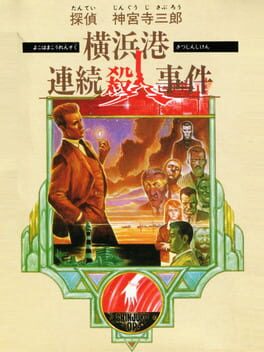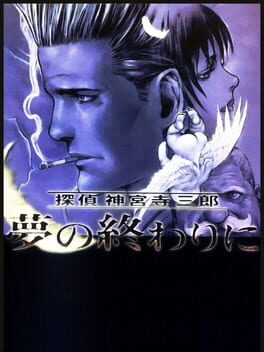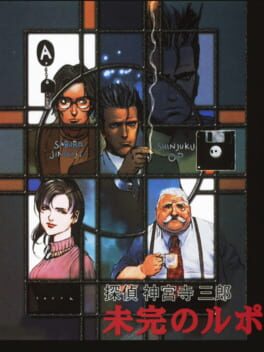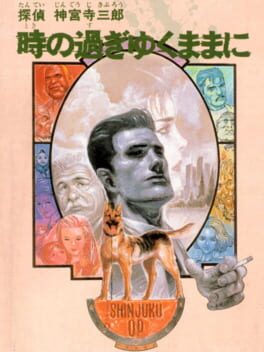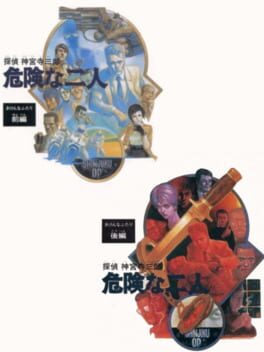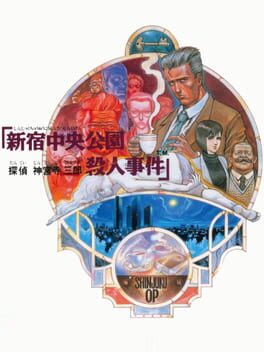Tantei Jinguuji Saburou: Yokohama-ko Renzoku Satsujin Jiken
released on Feb 26, 1988
The second game in the Tantei Jinguuji Saburo franchise. The top down RPG style investigation is removed in this game, making this a purely menu based adventure game. A murder happens in the port of Yokohama, as detective Jinguuji Saburo, you are tasked to investigate the twists and turns of the case to find the culprit.
Also in series
Released on
Genres
Reviews View More
'For practice, she started keeping big, American-style chunks of beef in the refrigerator, making steaks every night and serving them with lectures on "rare" and "medium" like some overzealous hotel waiter.'
– Akiyuki Nosaka, Amerika hijiki, 1968 (tr. Jay Rubin).
Played in preparation for my upcoming video essay on the Sumida River and urban watercourses.
The policies of the MacArthur administration during the occupation of Japan (1945-1952) were the driving force behind a lasting trauma in the Japanese collective unconscious, contrasting the wealth of the Americans with the difficult years of deprivation for the local population. By the end of the 1940s, Japan had become a key ally for the American regime, which was keen to establish an outpost in East Asia. Political tensions between the two countries culminated in 1959-1960 with the Anpo protests (Anpo tōsō), which split activist movements and reinforced anti-Americanism as a marker of identity [1]. More precisely, opposition to the United States was not limited to a rejection of Japanese foreign policy, but was a radical programme based on emotional and identity-based reactions. As Americanisation has transformed everyday life in Japan, the various artistic productions emphasise the creation of an in-between cultural space – neither fully American nor fully Japanese – as a result of the friction between the two cultures, something that Haruki Murakami's novels illustrate perfectly.
Anti-Americanism and socio-cultural hybridity in Japan
Although Yokohama-kō Renzoku Satsujin Jiken retains the same hard-boiled aesthetic as Shinjuku Chūō Kōen Satsujin Jiken (1987), the second title in the Tantei Jingūji Saburō series turns out to be more concerned with the presence of foreigners on Japanese soil [2]. The titular detective is assigned to investigate the disappearance of Eva Christina, who works in the consulate of the fictional Baraka. Jingūji is soon confronted with a series of murders and realises that these incidents are linked to a smuggling operation taking place in Yokohama. The different environments underline the exotic nature of the case, alternating between Western-style buildings, Japanese neo-urbanity and traditional memorials. Yokohama vibrates as a tourist city, a quality that the pixel art successfully conveys. The player is caught between views of the stadium, Chinatown and temples, all flanked by tall modern buildings.
Yokohama-kō Renzoku Satsujin Jiken follows the hard-boiled formula more closely, with the investigation refusing to be a honkaku mystery: the plot is linear and poses few significant problems, as the suspects are clear from the outset; the title rather emphasises the cultural and urban representation of Yokohama as it rapidly becomes westernised. At the end of the 1980s, the city was indeed restructured with a new business district, Minato Mirai 21, whose skyline mimics those of US East Coast cities. Remarkably, one of the central questions in the investigation revolves around a blue Mercedes-Benz, a telling sign of Western modernity – and it should also be noted that Consul Robert K. Busk speaks only in katakana.
An artificial thriller
While Yokohama-kō Renzoku Satsujin Jiken reflects a concern regarding the West and the difficult relationship maintained with Taiwan, the script is relatively unremarkable. The game seems forced to build itself around a series of murders to justify the 'renzoku' of its title. The suspense is pretty underwhelming, except for a few action scenes: Yokohama-kō Renzoku Satsujin Jiken more broadly embraces a cinematic approach, by lowering the difficulty compared to the previous episode. Having dispensed with its overhead-view and impromptu 'game over', the game is also more generous with clues; while it is still unlikely to complete the title by brute-forcing interactions, the mystery is straightforward enough to ensure that the player will not get overly confused.
The game also puts much more emphasis on its secondary characters, which perhaps explains some questionable narrative choices, although the dialogue feels much more natural. Yoko Gyoen is much more active, demonstrating excellent detective instincts; as a polyglot, she also acts as an interpreter when dealing with foreign characters. Although Yokohama-kō Renzoku Satsujin Jiken allows the player to choose their assistant, there is little reason to select Hinode Hitoshi, as Yoko proves to be far more capable and a welcome representation of women.
Yokohama-kō Renzoku Satsujin Jiken feels very complementary to its predecessor, offering a radically different progression and story. While the script is more coherent and avoids an implausible twist at the end, the ensemble is comparatively weaker. Similarly, the plot is simplified, but lacks the mysterious tension of the first episode – the title boasts a jazzier OST, but abandons the musical jingles for the critical clues that drive the investigation. Instead, the focus seems to be on the portrayal of Yokohama, the interference of Westerners in modern Japan, and the inability of the local authorities to act. As such, Yokohama-kō Renzoku Satsujin Jiken is a vivid illustration of Japan's conflicted relationship with the United States, halfway between fascination and loathing.
__________
[1] Students who lived through the waves of protest in the 1960s and 1970s were particularly affected by these events, whose political and aesthetic reverberations are both numerous and complex. On the topic, see Nick Kapur, Japan at the Crossroads: Conflict and Compromise after Anpo, Harvard University Press, Cambridge, 2018 and Gavin Walker (ed.), The Red Years: Theory, Politics, and Aesthetics in the Japanese '68, Verso, London, 2020.
[2] Unlike countries like Taiwan, where US domination has been essentially institutional, Japan is marked by its physical presence, hence the – sometimes misguided – ever-present metaphor of Japan as a prostitute. Margaret Hillebrand writes: 'Female sexual labor, organized crime, drug and alcohol abuse, inter-racial violence, and the McDonaldization of cultural life dominate the thematic plane, [...] all depict US influence as a virus that infects and destroys its host' (Margaret Hillebrand, Literature, Modernity and the Practice of Resistance: Japanese and Taiwanese Fiction (1960-1990), Brill, Leiden, 2007, p. 132).
– Akiyuki Nosaka, Amerika hijiki, 1968 (tr. Jay Rubin).
Played in preparation for my upcoming video essay on the Sumida River and urban watercourses.
The policies of the MacArthur administration during the occupation of Japan (1945-1952) were the driving force behind a lasting trauma in the Japanese collective unconscious, contrasting the wealth of the Americans with the difficult years of deprivation for the local population. By the end of the 1940s, Japan had become a key ally for the American regime, which was keen to establish an outpost in East Asia. Political tensions between the two countries culminated in 1959-1960 with the Anpo protests (Anpo tōsō), which split activist movements and reinforced anti-Americanism as a marker of identity [1]. More precisely, opposition to the United States was not limited to a rejection of Japanese foreign policy, but was a radical programme based on emotional and identity-based reactions. As Americanisation has transformed everyday life in Japan, the various artistic productions emphasise the creation of an in-between cultural space – neither fully American nor fully Japanese – as a result of the friction between the two cultures, something that Haruki Murakami's novels illustrate perfectly.
Anti-Americanism and socio-cultural hybridity in Japan
Although Yokohama-kō Renzoku Satsujin Jiken retains the same hard-boiled aesthetic as Shinjuku Chūō Kōen Satsujin Jiken (1987), the second title in the Tantei Jingūji Saburō series turns out to be more concerned with the presence of foreigners on Japanese soil [2]. The titular detective is assigned to investigate the disappearance of Eva Christina, who works in the consulate of the fictional Baraka. Jingūji is soon confronted with a series of murders and realises that these incidents are linked to a smuggling operation taking place in Yokohama. The different environments underline the exotic nature of the case, alternating between Western-style buildings, Japanese neo-urbanity and traditional memorials. Yokohama vibrates as a tourist city, a quality that the pixel art successfully conveys. The player is caught between views of the stadium, Chinatown and temples, all flanked by tall modern buildings.
Yokohama-kō Renzoku Satsujin Jiken follows the hard-boiled formula more closely, with the investigation refusing to be a honkaku mystery: the plot is linear and poses few significant problems, as the suspects are clear from the outset; the title rather emphasises the cultural and urban representation of Yokohama as it rapidly becomes westernised. At the end of the 1980s, the city was indeed restructured with a new business district, Minato Mirai 21, whose skyline mimics those of US East Coast cities. Remarkably, one of the central questions in the investigation revolves around a blue Mercedes-Benz, a telling sign of Western modernity – and it should also be noted that Consul Robert K. Busk speaks only in katakana.
An artificial thriller
While Yokohama-kō Renzoku Satsujin Jiken reflects a concern regarding the West and the difficult relationship maintained with Taiwan, the script is relatively unremarkable. The game seems forced to build itself around a series of murders to justify the 'renzoku' of its title. The suspense is pretty underwhelming, except for a few action scenes: Yokohama-kō Renzoku Satsujin Jiken more broadly embraces a cinematic approach, by lowering the difficulty compared to the previous episode. Having dispensed with its overhead-view and impromptu 'game over', the game is also more generous with clues; while it is still unlikely to complete the title by brute-forcing interactions, the mystery is straightforward enough to ensure that the player will not get overly confused.
The game also puts much more emphasis on its secondary characters, which perhaps explains some questionable narrative choices, although the dialogue feels much more natural. Yoko Gyoen is much more active, demonstrating excellent detective instincts; as a polyglot, she also acts as an interpreter when dealing with foreign characters. Although Yokohama-kō Renzoku Satsujin Jiken allows the player to choose their assistant, there is little reason to select Hinode Hitoshi, as Yoko proves to be far more capable and a welcome representation of women.
Yokohama-kō Renzoku Satsujin Jiken feels very complementary to its predecessor, offering a radically different progression and story. While the script is more coherent and avoids an implausible twist at the end, the ensemble is comparatively weaker. Similarly, the plot is simplified, but lacks the mysterious tension of the first episode – the title boasts a jazzier OST, but abandons the musical jingles for the critical clues that drive the investigation. Instead, the focus seems to be on the portrayal of Yokohama, the interference of Westerners in modern Japan, and the inability of the local authorities to act. As such, Yokohama-kō Renzoku Satsujin Jiken is a vivid illustration of Japan's conflicted relationship with the United States, halfway between fascination and loathing.
__________
[1] Students who lived through the waves of protest in the 1960s and 1970s were particularly affected by these events, whose political and aesthetic reverberations are both numerous and complex. On the topic, see Nick Kapur, Japan at the Crossroads: Conflict and Compromise after Anpo, Harvard University Press, Cambridge, 2018 and Gavin Walker (ed.), The Red Years: Theory, Politics, and Aesthetics in the Japanese '68, Verso, London, 2020.
[2] Unlike countries like Taiwan, where US domination has been essentially institutional, Japan is marked by its physical presence, hence the – sometimes misguided – ever-present metaphor of Japan as a prostitute. Margaret Hillebrand writes: 'Female sexual labor, organized crime, drug and alcohol abuse, inter-racial violence, and the McDonaldization of cultural life dominate the thematic plane, [...] all depict US influence as a virus that infects and destroys its host' (Margaret Hillebrand, Literature, Modernity and the Practice of Resistance: Japanese and Taiwanese Fiction (1960-1990), Brill, Leiden, 2007, p. 132).
